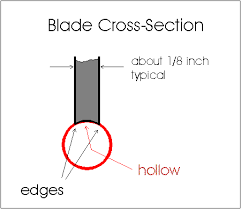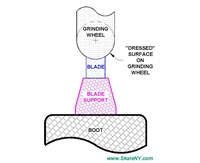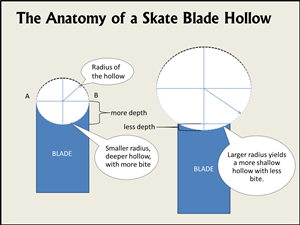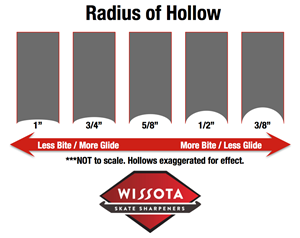 What the heck is blade hollow? And more importantly what does it have to do with the sharpness of my skates? Blade hollow is very important to your skating, yet I am amazed at how few people really understand the concept. And I’m not just talking about newbies to the sport. There are plenty of guys that have been playing their entire lives that don’t understand the concept. In part this is due to the fact that it is counter-intuitive. It also doesn’t help that we (in North America), use fractions (of an inch) rather than decimals (in mm) to measure it. Remind me again why I spent all that time in school learning the metric system? Sorry, I digress. Let’s start with some basic concepts.
What the heck is blade hollow? And more importantly what does it have to do with the sharpness of my skates? Blade hollow is very important to your skating, yet I am amazed at how few people really understand the concept. And I’m not just talking about newbies to the sport. There are plenty of guys that have been playing their entire lives that don’t understand the concept. In part this is due to the fact that it is counter-intuitive. It also doesn’t help that we (in North America), use fractions (of an inch) rather than decimals (in mm) to measure it. Remind me again why I spent all that time in school learning the metric system? Sorry, I digress. Let’s start with some basic concepts.
 1) The bottom of your blade is not flat, but rather concave. (See blade cross-section figure) This creates a hollow which allows your skate to cut into the ice. If you’ve ever put on a pair of skates out of the box (they don’t come sharpened), you’ve learned this the hard way. No hollow = No bite = Sore butt.
1) The bottom of your blade is not flat, but rather concave. (See blade cross-section figure) This creates a hollow which allows your skate to cut into the ice. If you’ve ever put on a pair of skates out of the box (they don’t come sharpened), you’ve learned this the hard way. No hollow = No bite = Sore butt.
2) Blade hollow measurements refer to the radius of the circle that is cut into the blade by the grinding wheel of the skate sharpening machine. The grinding wheel actually only grinds a small portion or arc of that circle into the blade. (See grinding wheel figure) Common hollows are 3/8″, 7/16″, 1/2″, 5/8″, 3/4″.
3) Now here is the part that is counter-intuitive: The smaller the radius, the deeper the hollow. I will repeat that. The SMALLER the radius, the DEEPER the hollow. Put another way, a smaller radius means a smaller circle. And the smaller the circle, the deeper that circle will go into the blade. Take a look at the pictures to get a visual of that concept.
 4) OK, now that we are clear on that, you also need to know that the deeper the hollow, the more the skate will bite into the ice. Given two pair of skates that have been freshly sharpened, the skates with the deeper hollow will be sharper. You can actually feel the difference as you run your fingers (carefully and perpendicularly) across the blades.
4) OK, now that we are clear on that, you also need to know that the deeper the hollow, the more the skate will bite into the ice. Given two pair of skates that have been freshly sharpened, the skates with the deeper hollow will be sharper. You can actually feel the difference as you run your fingers (carefully and perpendicularly) across the blades.
So now you say “Thanks Rick, I’ve now earned a PhD in the geometry and physics of skate blades. How is that going to help my hockey game?” Fair enough. While it’s great to have an understanding of blade hollow, the most important thing you need to know is what to tell the kid behind the counter when you hand him your skates. Let’s address that next. But don’t expect a definitive answer.
By this point you may have figured out that when you bring your skates in for sharpening, that it’s not simply enough to say “Sharpen my skates” as many players do. If you do this, they will just sharpen to whatever hollow they cut for most people, or whatever the wheel is set up to cut. And this may vary from shop to shop, or day to day. In other words, you won’t get a consistent hollow from one sharpening to the next, and you’ll never figure out what works better for you. Thus, you want to specify the hollow you would like.
So Which Hollow is Best for You?
 The answer is, it really depends. There are so many variables: How much do you weigh? A lighter player may need a deeper hollow to bite into the ice, whereas that same hollow may produce too much bite for a heavier player. What position do you play? A deeper hollow is better for making quick, sharp turns. But deeper hollows sacrifice glide. Thus, forwards tend to like deeper hollows than defensemen. And goalies generally use very shallow hollows, although even that is changing. How hard is the ice? For hard ice, you want more bite (deeper hollow), but that same hollow may cause too much bite on soft ice. So you may need to change your hollow from rink to rink, and by the season as ice conditions are generally softer in the summer.
The answer is, it really depends. There are so many variables: How much do you weigh? A lighter player may need a deeper hollow to bite into the ice, whereas that same hollow may produce too much bite for a heavier player. What position do you play? A deeper hollow is better for making quick, sharp turns. But deeper hollows sacrifice glide. Thus, forwards tend to like deeper hollows than defensemen. And goalies generally use very shallow hollows, although even that is changing. How hard is the ice? For hard ice, you want more bite (deeper hollow), but that same hollow may cause too much bite on soft ice. So you may need to change your hollow from rink to rink, and by the season as ice conditions are generally softer in the summer.
So there is no definitive answer to the question of “Which hollow is best for me?” You really need to experiment. I am 5′ 8″ (in thick socks) and 175 lbs., and I like a 1/2″ hollow. If you are under 200 lbs., this is probably a good starting point for hollow. If you weigh well over 200 lbs., try starting at a 5/8″ hollow. Then experiment from there. Do you feel like you’re digging in too much? Or is your skate chattering when you stop? Do you not feel like you have much glide? If you feel any of these conditions, then go for a shallower hollow. On the other hand, if you “blow a tire” (skates slip out and you fall) every time you make a tight turn, then you probably need to go deeper with the hollow.
The diagram from Wissota shows some typical hollows, and even though it is not to scale, it is great for illustrating the concept of deep vs. shallow hollows. However, keep in mind that those are not the only options. For instance, if 1/2″ feels too shallow, you don’t have to go right to 3/8″. You can ask for a 7/16″ hollow, which is actually a pretty popular hollow.
I hope this helps you understand the concept of hollow, and more importantly, helps you choose a hollow that makes you a better skater, and thus a better player.
-Rick Parisi, CEW, Weekend Warriors Hockey
